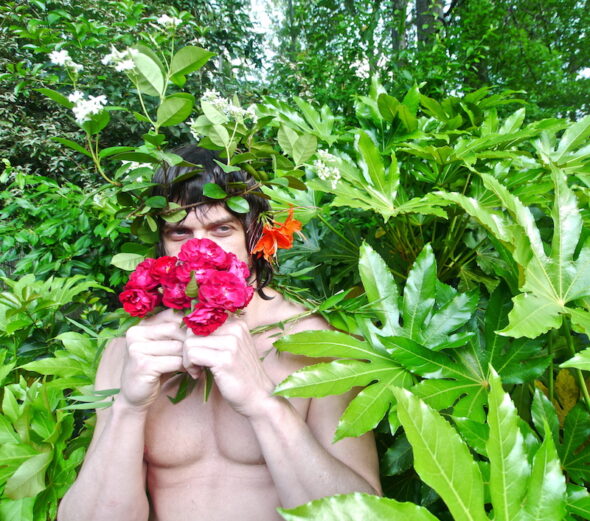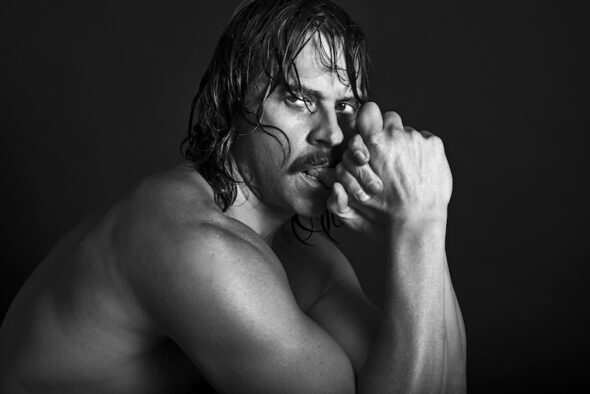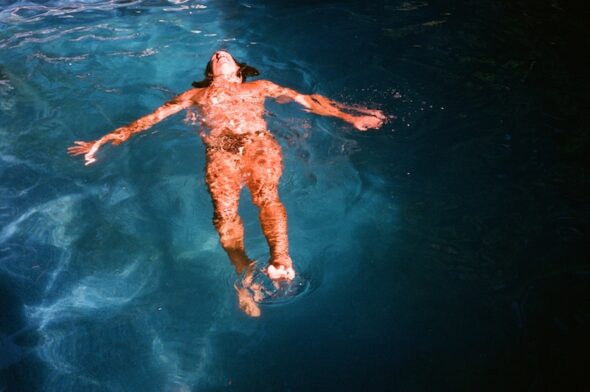Article by Adela Kim in Berlin // Friday, Apr. 13, 2018
In February 2018, almost nine years since its last album, the performance troupe Fischerspooner released the much-anticipated album ‘Sir’. Two months later, on April 7th, the duo opened an exhibition at the Neue Aachener Kunstverein as an artistic extension of the album. Titled ‘Sir: character studies, promotional materials, self actualization and contemporary photography 2013–18’, the exhibition investigates identity and character formation in the era of omnipresent social media. In addition to displaying photographs of one of its members, Casey Spooner, by both close friends and well-known photographers, the exhibition includes video sculptures in the surrounding park Stadtgarten. Berlin Art Link spoke to the pair, Casey Spooner and Warren Fischer, about the exhibition, social media and spectacle, as well as their cross-media artistic practices.

‘Casey Spooner’, 2015 // Photo by Jeremy Ayers, Courtesy of Fischerspooner
Adela Kim: What was the concept behind your newest album, ‘Sir’? What about the accompanying exhibition?
Casey Spooner: When I started writing songs for this record I knew instantly that I wanted to try to represent the narrative that I was living. I was leading a very nontraditional happy life, which was a long-term relationship that was open. I had numerous emotional sexual experiences that I did not feel were represented. I also felt that technologies were affecting all sorts of different relationships, from social media to sex apps. That was the original impetus for me.
Warren Fischer: From the beginning, we have always worked with a variety of media simultaneously. We would do photo shoots to explore characters, which would inform the lyrics that we write. Or Casey would develop a wardrobe, then we would write performance choreography to that. We don’t just sit down, write lyrics and then come up with an image for it. There is a much denser dialogue. The entire time we were making something, other ideas of what to do with this material were being generated. The exhibition in Aachen stems from our book ‘Egos’ from 2015, similar to last year’s exhibition at the Museum Moderner Kunst (mumok) in Vienna. But this exhibition is a kaleidoscopic, almost a summary of the visual elements of this creative cycle. It doesn’t have an image style or theme; it is more about contrasts and juxtapositions. And this specific hyper-narcissistic agenda that Casey laid onto this project was inspired by the maniacal narcissism of our social media age.
AK: In this project, then, are you investigating the influx of social media or trying to launch a critique? Can you differentiate between the two?
CS: The project is about entertainment and a portrait of entertainment. Especially, social media has become the most popular form of entertainment, perhaps more so than TVs or movies. When people have extra time and they want to entertain themselves, they use their phones. It made sense to evolve the project to be less of a critique. The music industry has atrophied since we have started to participate in it. There has been a shift away from music and towards images, in general. When you release a song now, no one cares about the music unless it has a video. We are living through a time where image has eclipsed music.

‘Casey Spooner’, 2017 // Photo by Vincent Urbani, Courtesy of Fischerspooner
AK: Can you elaborate on your decision to show photographs by friends as well as well-known photographers like Wolfgang Tillmans? Why blur the private and the public?
CS: I didn’t select the images. I don’t know what the show looks like, and Warren doesn’t either. We gave them the concept and general parameters and I have seen glimpses from the museum’s online posts. But there might be an image that I might not like and I have the right to intervene in the show. I won’t know until I get there, and maybe I won’t care, but if I do, I am allowed to destroy the image in the public setting. I have asked for a power sander to be on set.
AK: It has been said that when you founded Fischerspooner in 1998 in New York, you wanted to make the elitist art scene more open and accessible. How does that mission figure into your work now?
CS: The art world has changed a lot in the past 20 years. Performance was not a part of the museum culture. You would not have seen these blockbuster, site-specific exhibitions that are about amusement and entertainment. Museums have embraced spectacle as a part of their agenda. The rain room, the Kusama installations, or Björk retrospective: none of those things were happening in the museum twenty years ago. Whatever our theme was at the time, it has become a bit of a Zeitgeist.
AK: What do you mean by spectacle?
WF: I would say interactive, site-specific temporary works. Our definition of spectacle is to look at the more prosaic forms of art as the traditional art form, and then to play between the differentiated worlds. For instance, there are the creative zones of folk to pop music, photography, performance art and special effects. It goes back to how we develop creative ideas that permeate and can be communicated through different media. Other than this exhibition, we have done performances in galleries, private homes, construction sites, and large TV broadcasts. We try to disrupt the hierarchies, like the eternal predominance of paintings. We could probably make a list of most respected to least respected creative forms: painting, sculpture, maybe photography. It’s not that hard.
CS: I like to work in the art world because it’s very flexible. It’s more idea-driven and less market-driven. We can manipulate time and space very freely. Other forms of popular entertainment don’t allow that sort of flexibility. We like to work with the motifs, the clichés and the languages of entertainment. The perfect equation for us is using the best of both worlds: the power of the language of popular entertainment with the creativity and the resources of high culture. We’re not trying to dismantle it. Rather, we are trying to enter it and use it. I believe it helps both systems because it reinvigorates the status quo of the entertainment cycle that tends to stagnate.
WF: The only other thing that I would say that is a little different is that there is this desire to take complicated ideas to broader audiences and not talk down to them. I like to make things and I like to connect to audiences of different types.

‘Casey Spooner’, 2017 // Photo by Kristiina Wilson, Courtesy of Fischerspooner

‘Casey Spooner’, 2018 // Photo by Frédédric Monceau, Courtesy of Fischerspooner
AK: But while you say that the art world is less market-driven, some would argue the opposite: that the art world is irrevocably linked to the market, and that it must change.
CS: That argument goes nowhere. Museums and institutions can accept donations from people and it doesn’t actually diminish the idea of the process.
WF: If you’re in the middle of nowhere, then you are free from market pressure. But other than that, everyone has to suffer the same toil and conflict.
CS: This is part of society. It gives you something to push against; there is no utopia where you can produce in a vacuum. Bring on market pressure, bring on donor pressure. That’s what you need—there isn’t a world without conflict. My motto is: I love my problem.
Exhibition Info
NEUER AACHENER KUNSTVEREIN
Fischerspooner: ‘Sir: character studies, promotional materials, self actualization and contemporary photography 2013–18’
Exhibition: Apr. 8 – May 27, 2018
Passstraße 29, 52070 Aachen, click here for map























